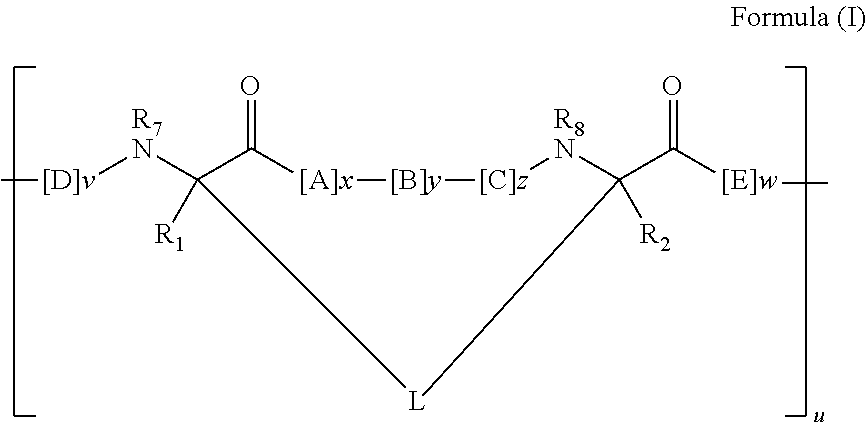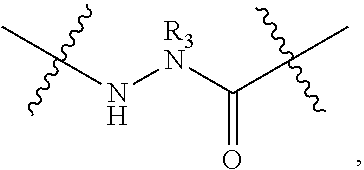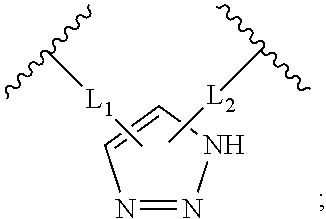Triazole-crosslinked and thioether-crosslinked peptidomimetic macrocycles
a peptidomimetic and macrocycle technology, applied in the field of triazole-crosslinked and thioether-crosslinked peptidomimetic macrocycles, can solve the problems of vulnerability of tumors that express wild type p53, and achieve the effects of stabilizing the alpha-helical secondary structure, inhibiting its destruction, and improving biological activity
- Summary
- Abstract
- Description
- Claims
- Application Information
AI Technical Summary
Benefits of technology
Problems solved by technology
Method used
Image
Examples
example 1
Synthesis of 6-chlorotryptophan Fmoc amino acids
[0558]
[0559]Tert-butyl 6-chloro-3-formyl-1H-indole-1-carboxylate, 1. To a stirred solution of dry DMF (12 mL) was added dropwise POCl3 (3.92 mL, 43 mmol, 1.3 equiv) at 0° C. under Argon. The solution was stirred at the same temperature for 20 min before a solution of 6-chloroindole (5.0 g, 33 mmol, 1 eq.) in dry DMF (30 mL) was added dropwise. The resulting mixture was allowed to warm to room temperature and stirred for an additional 2.5 h. Water (50 mL) was added and the solution was neutralized with 4M aqueous NaOH (pH˜8). The resulting solid was filtered off, washed with water and dried under vacuum. This material was directly used in the next step without additional purification. To a stirred solution of the crude formyl indole (33 mmol, 1 eq.) in THF (150 mL) was added successively Boc2O (7.91 g, 36.3 mmol, 1.1 equiv) and DMAP (0.4 g, 3.3 mmol, 0.1 equiv) at room temperature under N2. The resulting mixture was stirred at room temp...
example 1a
Synthesis of Alkyne Compounds for Use in Synthesis of Compounds of Formula I
[0566]
Synthesis of (5-iodopent-1-ynyl)benzene
[0567]To a solution of THF (200 mL) into reaction flask was added (5-chloropent-1-ynyl)benzene Phenylacetylene (10 g, 97.91 mmol). Then the reaction mixture was cooled to −78° C. in a dry ice bath. nBuLi (95.95 mmol, 38.39 mL) was added dropwise and allowed to react for 0.5 h at −78° C. At −78° C., 1-bromo-3-chloropropane was added. Stirred for 5 hours during which the reaction was allowed to warm up to room temperature. Then reaction was refluxed at 90° C. for 3 hours. The solvent was distilled off, then water (150 mL) and ether (150 mL) was added. The crude product was extracted, ether was distilled off and the resulting crude mixture was dissolved in acetone. Sodium iodide (22.92 mmol, 3.44 g) was added into the solution. The reaction mixture, with reflux condenser attached, was heated to 70° C. for two days. Acetone was distilled off using short path distillat...
example 2
Peptidomimetic Macrocycles of Formula I
[0576]Peptidomimetic macrocycles are prepared as described herein and as in pending U.S. patent application Ser. No. 12 / 037,041, filed Feb. 25, 2008, which is hereby incorporated by reference in its entirety. Peptidomimetic macrocycles are designed by replacing two or more naturally occurring amino acids with the corresponding synthetic amino acids. Substitutions are made at i and i+4, and i and i+7 positions. Peptide synthesis is performed either manually or on an automated peptide synthesizer (Applied Biosystems, model 433A), using solid phase conditions, rink amide AM resin (Novabiochem), and Fmoc main-chain protecting group chemistry. For the coupling of natural Fmoc-protected amino acids (Novabiochem), 10 equivalents of amino acid and a 1:1:2 molar ratio of coupling reagents HBTU / HOBt (Novabiochem) / DIEA are employed. Non-natural amino acids (4 equiv) are coupled with a 1:1:2 molar ratio of HATU (Applied Biosystems) / HOBt / DIEA. The N-termini...
PUM
| Property | Measurement | Unit |
|---|---|---|
| fluorescent | aaaaa | aaaaa |
| binding affinity | aaaaa | aaaaa |
| binding affinities | aaaaa | aaaaa |
Abstract
Description
Claims
Application Information
 Login to View More
Login to View More - R&D
- Intellectual Property
- Life Sciences
- Materials
- Tech Scout
- Unparalleled Data Quality
- Higher Quality Content
- 60% Fewer Hallucinations
Browse by: Latest US Patents, China's latest patents, Technical Efficacy Thesaurus, Application Domain, Technology Topic, Popular Technical Reports.
© 2025 PatSnap. All rights reserved.Legal|Privacy policy|Modern Slavery Act Transparency Statement|Sitemap|About US| Contact US: help@patsnap.com



